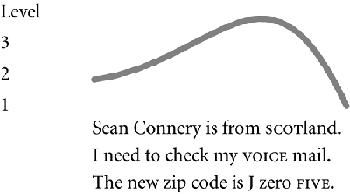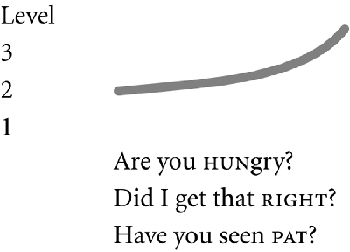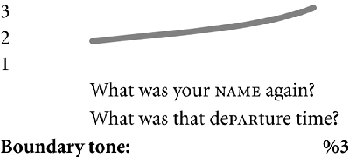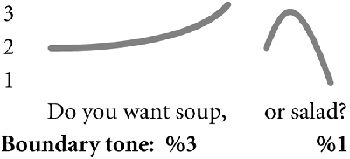Intonation Patterns of English Language
Intonation is the variation in pitch while speaking - not on a word-level but on a statement-level.
By learning how native speakers use varying intonations, we can accurately understand what people try to communicate with us. As we listen closely to the melody of their speech, we can figure out their feelings, sense their moods and attitudes, and recognize questions, commands/requests and offers, ergo, properly respond to them.
We say “I beg your pardon” with a rising intonation to ask someone to repeat his statement, yet we use the falling intonation for “How may I help you?” to offer our service. When do we use these two basic intonation patterns in English?
1. Falling tune - a pattern in which our voice falls to a low pitch by the end of a thought group or statement. We use the falling intonation in the following cases:
2. Rising tune -a pattern in which our voice rises to a high pitch by the end of a thought group or statement. We use the rising intonation in the following situations:
from: http://www.myesl.info/accent/intonation-patterns.html
|
|
To characterize these three contours, let's assume for simplicity only three relative levels of pitch: Level 1 is the lowest , level 2 is midrange , and level 3 is the highest.
A few disclaimers are in order:
- These numbers are not in any way intended to represent precise pitch values. They are best regarded as ranges of possible pitches. For example, the rising-falling, nonfinal contour both starts and ends at a midpitch level, but this does not mean that it starts and ends on exactly the same melodic note. Rather, the contour starts and ends in the same relative pitch range.
- The intonation system proposed here is not to suggest that there are only three levels of tone. For example, a fourth tone, higher than level 3, is often used in particularly emotive discourse , but this is not relevant to the VUIs we have deployed.
- The inventory of contours presented here is not intended to be exhaustive. They are only the most basic ones.
- The contours presented here are greatly simplified and are intended to serve as abstractions. For example, there may be a number of intonational peaks in any of these contours, depending on the details of sentence -level stress placement.
Rising-Falling, Final
Figure 11-1 shows the default pattern for simple declarative sentences. However, like many of the patterns that follow, this particular contour has additional uses. These are relevant for concatenation and are described shortly.
Figure 11-1. The rising-falling, final contour is the default pattern for simple declarative sentences.

Remember that the graphical representations of intonation contours throughout this chapter are not intended for accuracy but serve only as basic sketches . These abstractions are effective in illustrating certain key aspects of intonational grammar, in particular the concept of boundary tones, which is explained shortly.
The delivery of a statement as depicted in Figure 11-1 is neutral. By default, it begins at a midlevel, then rises, and then falls to a relatively low pitch. As noted earlier, the peak, which reaches level 3, predictably falls on the stressed syllable of the rightmost open -class item of the utterance—here, " VOICE mail." (The prominence peak is marked by the use ofSMALL CAPS .) Of course, because the statement peaks on " VOICE mail," it cannot serve as a response to "W HO is checking voice mail?" or "What are you DOING with your voice mail?" In these cases, the peaks would be "I" and "CHECKING ," respectively.
Significantly, in English intonation structure, intonational meaning is signaled at the right edge (the end) of the utterance, and often at the right edge of smaller phrasal constituents. These tonal markers are known as boundary tones(Pierrehumbert 1980). This concept is crucial not only for proper concatenation but also for the proper recording of prompts in general.
For convenience, linguists represent boundary tones by using the percent sign (%). This use of the percent sign has nothing at all to do with arithmetic; for example, "%1" means that a particular utterance or phrase ends at pitch level 1. Because the three intonation contours are distinct at their right edges and because the rising-falling, final pattern ends at pitch level 1, let's refer to this pattern as contour 1 .
Rising
The rising contour (Figure 11-2) is most often associated with yes/no questions. This contour also serves other functions, described later.
Figure 11-2. The rising contour is often associated with yes/no questions.

Like contour 1 in Figure 11-1, the rising contour starts at midlevel but ends in a high boundary tone, %3. We therefore refer to the rising pattern as contour 3 .
Rising-Falling, Nonfinal
This pattern corresponds to the first of the pair of clauses (the dependent or subordinate clause) in each sentence in Figure 11-3. (The second in each pair is a type 1 contour, as described earlier.)
Figure 11-3. The rising-falling, nonfinal contour reflects complex sentences.

The dependent clauses "as soon as Pat got home," "to speak to an operator," and "as of June twenty-third" are in the nonfinal position. There is more to follow to complete the thought, and this is signaled intonationally via a contour that does not fall as low as in the case of final phrases. Because this pattern ends at midlevel, %2, let's refer to it as contour 2.
Contour 2 can sometimes be used as a nonfinal building block for longer contour 1 messages. See, for example, the concatenation plan for sentences such as "Transferring one hundred dollars from checking to savings" in Figure 11-4.
Figure 11-4. You can use contour 2 in association with contour 1 messages.

Ideally, this utterance would constitute a single breath group , ending at %1. To facilitate recording and concatenation, however, it may be helpful to think of Figure 11-4 as a linking of two smaller constituents: contour 2 plus contour 1. In this example, the concatenated phrase "Transferring | X dollars" could be spoken as a contour 2 pattern, whereas the phrase "from savings to checking" must be a contour 1 pattern.
Later in this chapter, you will see that contour 2 is especially relevant for the concatenation of phone numbers, which begin with a kind of subordinate clause (in the case of seven-digit numbers) or with two such clauses (in the case of ten-digit numbers).
11.4.2 Contours in Context
Now we turn to the use of the basic contours in context. This discussion is particularly relevant to the concatenation of messages.
Lists
Lists are ubiquitous in speech applications, particularly when you offer the user numerous choices, as in menu and help prompts. Depending on the nature of the application, it is sometimes desirable or even necessary to concatenate lists when the choices vary or when the length of the list itself is variable, as is often the case with dynamically generated lists.
With proper planning, it is easy to make concatenated lists sound natural. This is because list items are often surroundedby a slight pause in naturally occurring discourse, especially when the delivery is slow or emphatic. Because these concatenation units are cushioned by silence, less attention is drawn to the undesirable splicing effect that generallymarks concatenation junctures.
Figure 11-5 depicts default list intonation, although other list patterns are also possible.
Figure 11-5. This sentence uses default list intonation.

Lists consist of a series of contour 3 phrases, ending with contour 1. [4]
[4] There are other, less common intonation patterns for lists. See, for example, Quirk and Greenbaum (1973).
Figure 11-6 shows the concatenation plan for an error prompt that provides the caller with a list of choices.
Figure 11-6. This concatenation plan helps listeners comprehend a list of choices.

Note that "and sports," as well as "and rye," are best treated as a single concatenation unit. The reason is that in natural speech, this phrase is phonetically continuous, with no break between the conjunction ("and,") and the final option. Notice also the use of pauses. These correspond with naturally occurring breaks and ensure a more natural result despite concatenation.
Yes/No Questions
Questions that expect a response of either yes or no are called yes/no questions . In North American English, these sentences generally conform to the basic rising pattern. Concatenation items that fall at the end of such questions must therefore conform to contour 3, ending in a high tone.
The example in Figure 11-7 show the concatenation plan for a prompt confirming dates—for example, "Did you say Saturday, January first?" or "Did you say Monday, May twenty-second?"
Figure 11-7. This concatenation plan covers a prompt that confirms dates.
The concatenated result should convey contour 3, that is, a steady rise from level 2 to 3. In addition, phrasing should reflect natural speech. When we say a date such as "Wednesday, June seventh," it is possible to pause between the day of the week and the rest, as indicated by the comma. Observing this pause during recording will facilitate natural-sounding concatenation, because the pause will coincide with the concatenation splice. In contrast, because the month and the ordinal constitute a continuous, fluid stream in natural speech, the voice actor should leave only the slightest of pauses between the month and the ordinal—only enough for the sound engineer to isolate the desired wave files, but not so much as to suggest an explicit break or sense of separation.
If it is feasible , you can avoid concatenation altogether by recording all necessary yes/no possibilities for a given context, as in the prompt set in (17).
(17)
Did you want the home phone?
Did you want the work number?
Did you want the cell phone number?
There is no need to concatenate such simple questions as these. Nonconcatenated prompts will sound better.
Wh- Questions
Wh- questions are questions that start with who, what, where, when, why , and how . They are also called information questions , because their function is to elicit information, in contrast to yes/no questions, whose function is to elicit either an affirmation, agreement, or acceptance, on the one hand, or denial, dissent, and rejection on the other.
Wh- questions have two possible intonation structures, depending on the underlying intent. Usually, Wh- questions function as first-time requests for information. Figure 11-8 depicts the basic pattern for Wh- questions.
Figure 11-8. The basic intonation pattern of Wh- questions is contour 1.

The default intonation structure of Wh- questions is contour 1. There is, however, another possible use of Wh- questions, which is to request repetition or clarification , as when we hear "What's your name?" or "What was your name again?" (Figure 11-9).
Figure 11-9. The default intonation structure of Wh- questions that ask for repetition or clarification is contour 3.

The intonation of requests for repetition or clarification is contour 3, the same as for yes/no questions.
The prosodic distinction between Figure 11-8 and Figure 11-9 is important for recording prompts and messages, regardless of concatenation. The function of most error prompts is to request repetition. The voice actor should therefore inflect such requests as in Figure 11-9, with contour 3, rather than as in Figure 11-8, with contour 1. Of course, if the voice actor is reading a list of prompts bereft of context and if direction is inadequate, there is little chance of capturing the appropriate prosody.
As you have seen, when contrastive stress is used appropriately, the use of suitable intonation contours also gives the impression that the system possesses humanlike intelligence and is attentive to the progress of the dialog. Consider example (18).
(18)
|
The first prompt should be contour 1 (falling), and the second prompt contour 3 (rising). In this way, the system's intonational behavior will comply with callers
Before we move on to the next intonation pattern, let's briefly evaluate a popular but wrong idea about questions in English. It can be summed up as follows: "Whenever you see a question mark, your voice should go up." Some English teachers dispense this advice to nonnative speakers , and there are even text-to-speech engines that have been designed to uniformly impose a rising intonation contour on all sentences ending in a question mark, including Wh- questions. As you have seen in this section, however, first-time requests for Wh- information do not "go up" without coming back down, and down low. The next section describes another type of question that also ends on a low tone.
Either/Or Questions
Either/or questions aim to get the listener to choose one of two or more explicitly stated options rather than provide a simple yes or no. Because they function as information questions, they end on a low tone (%1), in accordance with first-time information requests, described earlier. Figure 11-10 shows an example of an either/or question. [5]
[5] Of course, it is also possible to use a continuously rising pattern, but then the question in Figure 11-10 becomes a yes/no question. The answer would be "Yeah, soup" or "Yes please , salad."
Figure 11-10. An either/or question ends on a low tone.

Questions with more than two options, as in Figure 11-11, follow the intonation pattern typical of lists.
Figure 11-11. Multiple-choice questions follow the intonation pattern of lists.

The intonation patterns of simple as well as complex either/or questions can be generalized as follows: The last list item must fall to a low tone (contour 1), whereas the others must rise to a high tone (contour 3).
As in the case of lists, "or" plus the final option should be recorded as a continuous chunk , without the intrusion of a concatenation splice.
This pattern has other uses, such as reporting a pair of temperatures in a weather report (19).
(19)
. . . with a high of twenty- TWO , and a low of thir TEEN .
|
From: http://flylib.com/books/en/2.133.1.72/1/
What is a tag question?
A tag question is a short question added to the end of a positive or negative statement.
For example:-
He is,
|
isn't he?
|
He does,
|
doesn't he?
|
He will,
|
won't he?
|
He can,
|
can't he?
|
How are they formed?
Normally a positive statement is followed by a negative tag, and a negative statement is followed by a positive tag.
For example:-
| + | - |
|---|---|
You're English,
|
aren't you?
|
| - | + |
You're not German,
|
are you?
|
!The statement and the tag are always separated by a comma.
! Treat any statements with nothing, nobody etc like negative statements.
The verb in the statement should be the same tense as the verb in the tag.
For example:-
| Present tense |
| present tense
|
|---|---|
| You are a good singer, | aren't you? |
| Past tense |
| past tense
|
| You didn't go to work yesterday, | did you? |
| Present perfect tense |
| present perfect tense
|
| You have been to London, | haven't you? |
If the verb used in the statement is an auxiliary verb, then the verb used in the tag must match it. If a modal (can, could, will, should, etc.) is used in the statement, then the same modal is used in the tag part. If the statement doesn't use an auxilliary verb, then the auxiliary do is used in the tag part.
For example:-
| Auxiliary verb | !Note | |
|---|---|---|
| She is from England, | isn't she? | |
| They aren't very nice, | are they? | |
| She doesn't like it here, | does she? | |
| Modal verb | ||
| You can sing, | can't you? | |
| They shouldn't do that, | should they? | |
| No auxiliary | ||
| He eats meat, | doesn't he? | (He does eat meat...) |
| He had a bath, | didn't he? | (He did have a bath...) |
| Nothing happened, | did it? | (Nothing did happen...) |
Why do we use them?
Tag questions are used to verify or check information that we think is true or to check information that we aren't sure is true. Sometimes we just use them for effect, when we are trying to be sarcastic, or to make a strong point. So be sure to use them with care.
We show the meaning of the tag question through intonation.
If the tag is a real question it has a rising intonation.
For example:-
If the tag is not a real question it has a flat or falling intonation.
For example:-
It's a nice day today, isn't it?
! It is possible for a positive statement to be followed by a positive tag for even more effect (sarcasm, anger, disbelief, shock, concern etc.).
For example:-
from: http://www.learnenglish.de/grammar/tagquestions.htm
Sentences of yes-no question intonation patterns.
Figure 11-2. The rising contour is often associated with yes/no questions.

Sentences of Information questions intonation patterns.
Wh- Questions
Wh- questions are questions that start with who, what, where, when, why , and how . They are also called information questions , because their function is to elicit information, in contrast to yes/no questions, whose function is to elicit either an affirmation, agreement, or acceptance, on the one hand, or denial, dissent, and rejection on the other.
Wh- questions have two possible intonation structures, depending on the underlying intent. Usually, Wh- questions function as first-time requests for information. Figure 11-8 depicts the basic pattern for Wh- questions.

The default intonation structure of Wh- questions is contour 1. There is, however, another possible use of Wh- questions, which is to request repetition or clarification , as when we hear "What's your name?" or "What was your name again?"

No hay comentarios:
Publicar un comentario